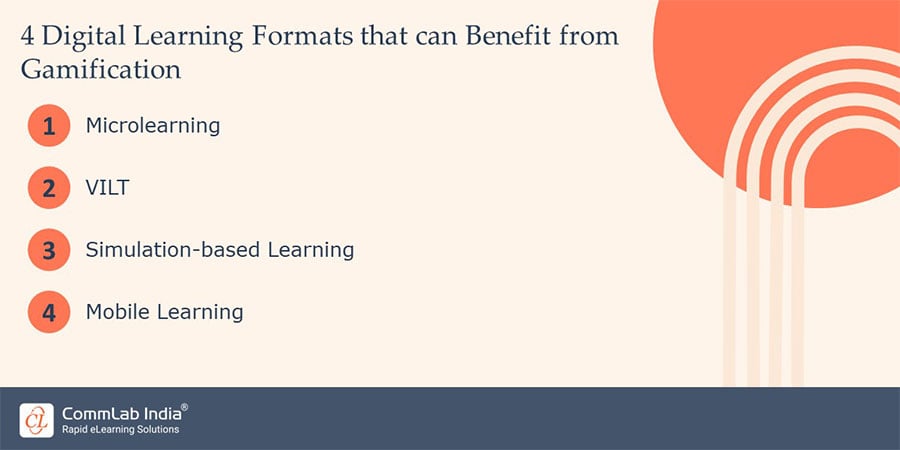Incorporating Gamification in Digital Learning for a Fun Learning Experience

Being a corporate training professional is about finding the best way to deploy the training modules. But you will agree no matter how good the training material is. It requires an interesting angle to optimize its ROI. The crucial factor here seems to be the “interest of the learners.” So, what is it that can make training sessions enjoyable for them?
The answer to this question is gamifying it. Yes, all work and no game will not make for the right amount of enthusiasm among trainees. And by adding element of games, the instructor can be assured of high levels of engagement from employees. In this blog, let’s talk about ways to add gamification to digital learning.
Some digital learning formats where we can leverage gamification are
- Microlearning
- VILT
- Simulation-based Learning
- Mobile Learning
Gamification- All Work and Some Game
Gamification refers to adding game elements to the process of learning. As we know games work on the principle of overcoming constrains to reach a certain reward. So as to create curiosity and motivation in the participant’s minds and encourage them to move ahead.
Simply put, gamification is about adding game elements to learning. This path consists of small milestones, where each milestone has a certain challenge to overcome. And symbolizes a level accomplished.
These milestones are designed in such a way that each one of them adds something to the learning of the participant. Passing a level also gives a sense of achievement to the learners. This, in turn, motivates them to keep moving ahead. Let’s explore ways to add gamification to 5 popular digital learning formats.

Gamification in Digital Learning Formats
Microlearning
Microlearning is about deploying training modules in small manageable chunks. That’s why it’s vital to gamify those modules, as accessing the material one after the other may become monotonous.
To start with, micro quizzes and drag-and-drop games can be added after regular interval of time. This can help to gauge the level of knowledge a participant has gained. Similarly, games like unlocking information after a specific goal is fulfilled can help inculcate a sense of curiosity among learners. These modules can be made more interesting by adding timers where learners have to complete the task in a certain time given. This will give participants a much-needed boost in confidence.
VILT
Virtual instructor-led training is about replicating the classroom setup in a virtual one. So that training can reach more participants without its essence being lost. As the trainer and learners are at different locations, adding gaming elements here is imperative to make the learners more proactive.
This can be done by assigning tasks and acknowledging their completion by giving encouragement in the form of points and badges. Accumulated points can be used to unlock rewards, such as additional resources or exclusive content. This can also provide opportunities for peer feedback and recognition.
Another good way to add gamification to a VILT session is by integrating interactive polls during the training. The result of these polls can be used as a subject of discussion among the participants. This can help open the channels of communication between remote and hybrid teams effectively.
→ Download Now: eLearning Trends 2023
Simulation-Based Learning
Simulation-based learning refers to the type of training where learners are exposed to real-life situations through simulations. Here individuals can apply skills from the real world to the situation presented, without any repercussions in a safe atmosphere.
Such a training can also open a dialogue among the learners, allowing them to work in teams or groups. Gamified scenarios can be designed, where participants can be encouraged to navigate challenges and make decisions. This can present branching paths and multiple outcomes based on their choices, allowing participants to see the consequences of their actions.
The simulations can be set into scenarios that can provide replay value and encourage experimentation.
Mobile Learning
Mobile learning refers to learning modules that are presented through the medium of mobile. Structuring the mobile learning content into levels or stages can be a good idea to make it interactive. Here learners can be given a chance to complete levels to demonstrate their proficiency. This can in return unlock new content for them.
As mobile learning may mostly take place, offsite it has a limited scope of interaction among participants. In such a situation, quizzes and leaderboards can be incorporated to boost motivation. A feeling of social recognition can be inculcated with this.

Wrapping Up
Gamification in digital learning is about adding game mechanics to the learning process. Different elements of gamification add a lot of value to digital learning.
Yes, adding a fun element can be a tool to move ahead but not the final goal.
Learning is a process and not an event and that’s why, learning and development industry keeps evolving with new trends. To know about latest eLearning trends download our eBook.





